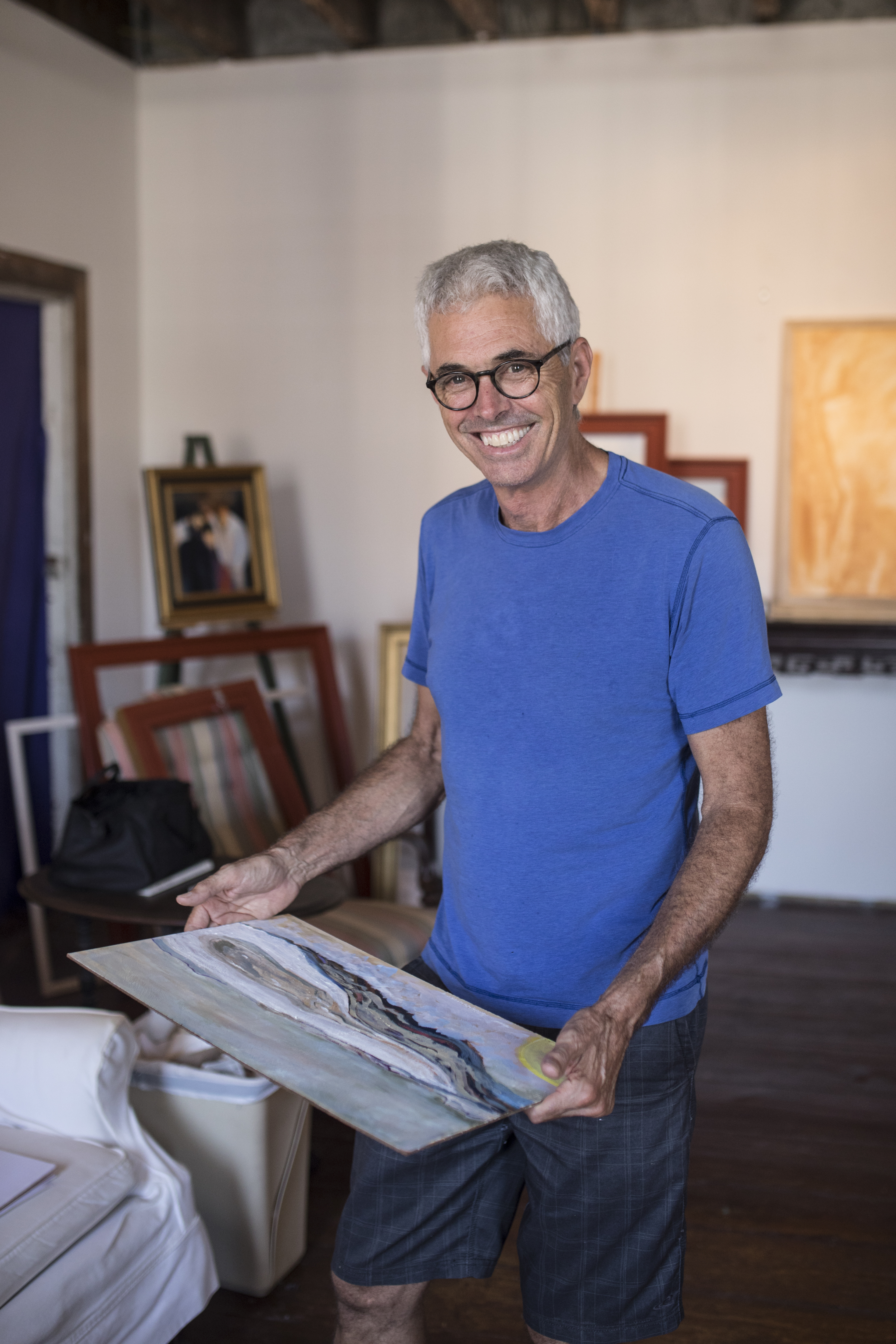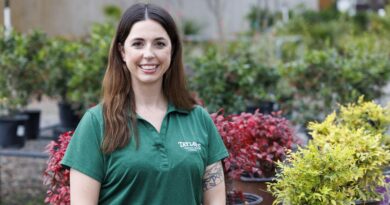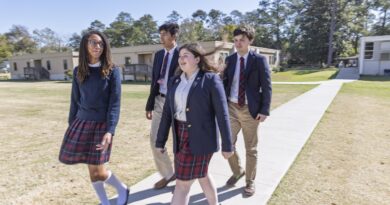Louis Bruce
Louis Bruce
If the door to my studio is open, it means come in.
Story By Mary Ellen Thompson Photos By John Wollwerth
Louis Bruce started his career as a artist in photography. “I inherited a camera from my father. I always knew how I wanted things to look but there was always something, a fire hydrant, a power line, in the way. And I realized I could do a painting without those things.
I was never into photo-realism. When I first started to paint I ran into a long-time painter who said ‘I’m going to make your life easy. Start with an accurate picture, then mess it up.’ I’ve taken his advice,”.
“Another technique I use is that I end up cropping paintings. I take them off the stretcher, cut them, and re-stretch. It’s a drive I have so that I can have the painting arranged in a way that pleases me. Sometimes I laminate the canvas to wood and then cut it with a table saw. Sometimes half is better. I’ve done some paintings that wound up to be two paintings.”
“I usually start with a coat of under paint,” he explains as he points to a canvas with only one color, but a distinct pattern. “This is just a start; put a horizon in and you’ve got a painting.” I use the same color for the under paint, raw sienna, because I like a warm painting and if I let some of it come through, it also makes a nice skin tone. I’m also not just faced with a white canvas.”
Referring to a canvas covered in raw sienna with an almost abstract shape, Louis isn’t sure yet if that painting resembling the figure of a woman is finished. “Look around my studio, there are how many, six, paintings of my wife? It’s a process; when you want to paint someone in particular, it’s a challenge.”
One of his large seascapes was purchased for the restaurant Hearth. It is an extraordinary rendition of waves, just waves. And although Louis may not be into photo-realism, when you look at that painting you can almost taste salt, and hear a wave moving towards shore. Really good paintings of waves are difficult to come by; many lack the appropriate field of depth. Louis’ explanation of his accuracy is delivered with a broad smile and a laugh tinged with nostalgia, “I was a surfer forever. I have vast wave knowledge; I come by it honestly. I spent two years chasing waves on the north shore of Maui. After Maui, I spent some time surfing in Costa Rica.”
Ok, let’s back up here for a second. How did he get from Maui to Beaufort? “I went to Hawaii after college; that was about a hundred years ago. I grew up in Santa Barbara. Both my parents were from South Carolina; my dad was a POW so I could go to a state school on the GI Bill. I went to the College of Charleston, where I was a biology major. After Hawaii, I came back to Charleston where I worked in the restaurant business and met my wife, Kit. Her dad was in the paving business, I worked for him, eventually took over that business and finally sold it. Then I started Palmetto Brewery with a partner; it was the first brewery in South Carolina in one hundred years.”
“I did all the artwork for the labels and packaging; it wasn’t painting, but it was art. I worked in the brewery for ten years when I realized that my partner was running the business and didn’t really need me on the payroll.”
Living in Mt. Pleasant at the time, Louis and Kit were buying and renovating houses in the Charleston area but they had branched out and bought a small house in Port Royal. In 2003 they moved to Beaufort, where Louis was able to devote his time to painting.
Louis’ artistic desire was born in Florence Italy in 2004 when “We wanted to buy a painting for $1500 we saw hanging in a restaurant. The manager very excitedly said, ‘Great let me bring some wine!’ He had to call the artist first so we had to wait a while. He came back with ‘No, it’s my favorite.’ So I said ‘I’ll paint one myself’. That was nearly 1000 paintings ago. I took lessons, but I really was taught by a guy named Peter Rolfe. He’s a life long painter and he taught me everything.”
In his studio, above Hearth, Louis says, “If the door is open, it means come in.” Up a steep flight of stairs, lies his wonderful space. “This is a perfect studio, it has reflected north light. It’s what they all want in Paris, that north light. I have a studio at home, but it’s better here. I can go down the street and get a cup of coffee, it’s like my big outing.”
Louis and Kit go to Italy for months at a time where he loves to paint. He takes his traveling easel, sets it up anywhere and paints. “I like Italy a lot. The first time we went to Rome and I did five paintings; this year we went for four months and I did thirty. We went to France on one of the trips and I wanted to paint from the bank of the Seine, where you see so many artists painting. I did a painting of Notre Dame. When I got home, I cut the painting in half and then moved Notre Dame to another part of the canvas.”
If Louis could be anywhere in the world where he could just walk out the door and paint, where would it be? “Italy, I like it a lot, even though my Spanish is better than my Italian. I have rudimentary Italian, the food is great, and we have friends there. But sometimes the answer is New York City. I like to go to Roosevelt Island where you’re across from the Manhattan skyline. I did a painting there that I brought back home and did as a triptych where all the panels are interchangeable.”
His paintings are for sale at McDonald Marketplace in Frogmore on Saint Helena Island which is a beautiful place that can showcase some of his larger pieces. He mostly paints scenery, “Landscapes sell, (paintings of) people stay. Big stuff is just like painting little stuff – you have to have an idea before you start. Sometimes I spend more time thinking about a painting, than I actually do painting it. Some artists take so long to do a painting that they want lots of money for it. I think the longer it takes, it’s not getting any better, so it has to go. Some of the best paintings I’ve ever done are paintings over old paintings.”
Louis’ art is unexpected. Some paintings are huge, some tall and thin, some landscapes, seascapes, figures, portraits, small paintings. Some have surprises like the series of oyster shells in which the oyster is the figure of a woman. “I price my art to sell,” he says. “I aspire to abstract. I did one large abstract, but it turned into a fish camp; I did a painting of an art gallery that became a landscape. I paint mostly in muted, rather than bright, colors.” When he’s not painting, Louis has enjoyed the Pat Conroy Literary Center talks he has attended; and he likes to cook. But mostly he’s thinking about painting.




